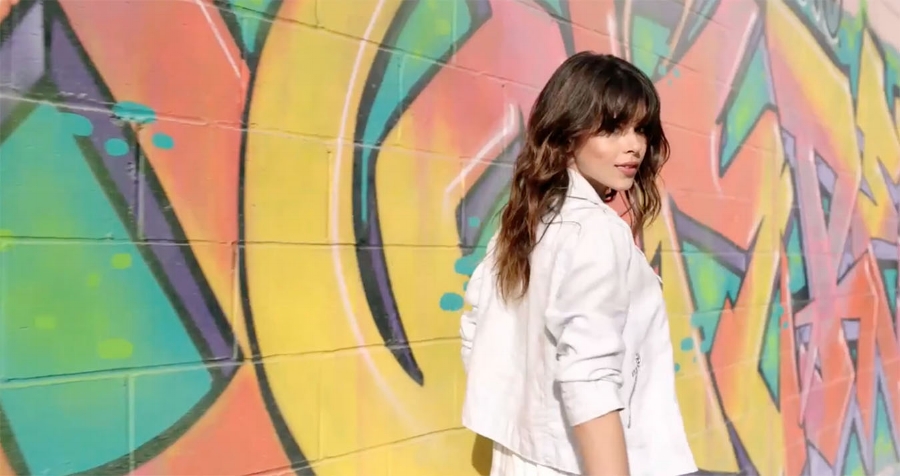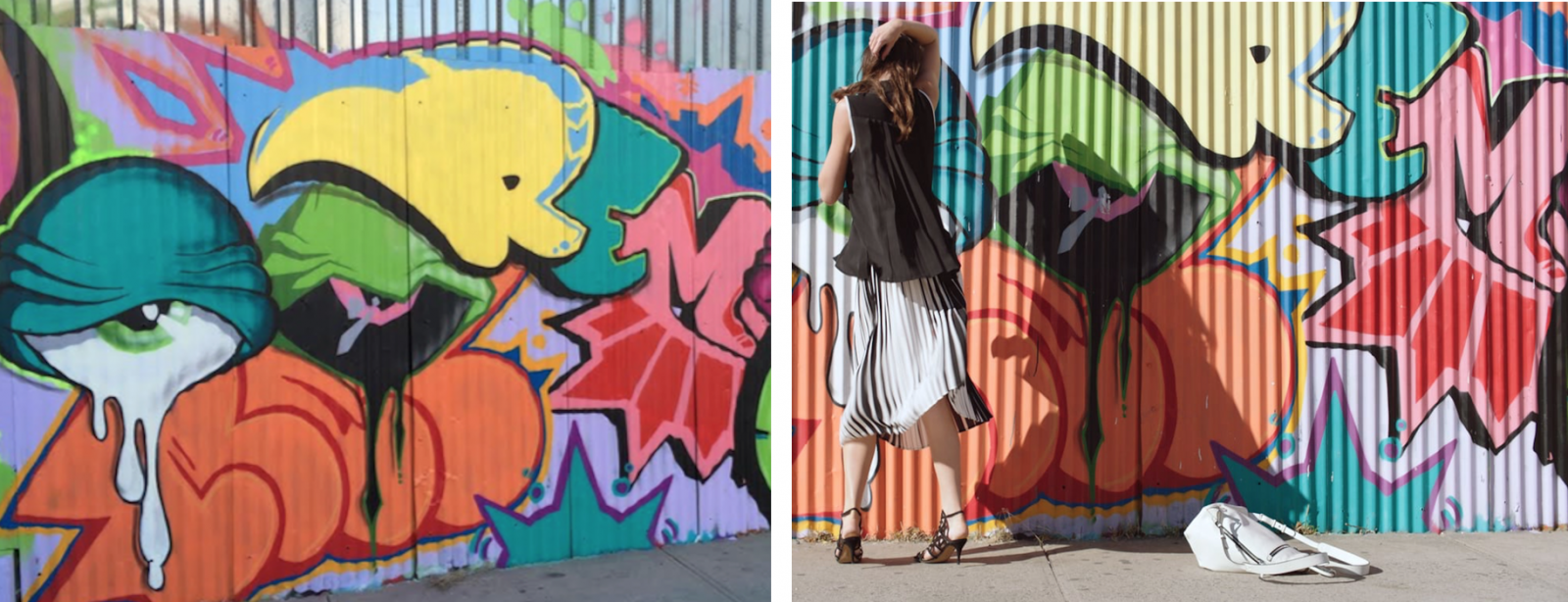
image: Vince Camuto
Vince Camuto has been slapped with a copyright infringement lawsuit for allegedly making use of a group of well-known street artists’ work for its Spring/Summer 2017 ad campaign. According to the complaint, which was filed last week in the U.S. District Court for the Central District of California, Vince Camuto “inexplicably featured [artists Joseph Tierney, Cary Patraglia, Spencer Valdez, and Keith Rowland’s] murals as the centerpiece of a marketing campaign for its Spring/Summer 2017 line without [their] knowledge or consent.”
Tierney, Patraglia, Valdez, and Rowland – who respectively go by “Rime,” “Host18,” “Taboo,” and “Reme” – alleged that in February 2017, Camuto launched its campaign, which “included both video, and still imagery featuring the [Brooklyn, New York-located] murals.” The campaign was shared on “Camuto’s social media accounts, including YouTube, Instagram, Twitter, and Facebook; and was featured on various fashion websites. Still images of the murals taken from the campaign were also featured throughout Camuto’s own website, and the websites of third party retailers, including Macy’s.”
And still yet, “the campaign video was also broadcast in taxi cabs throughout New York and displayed inside Camuto’s retail stores.”

Reef’s mural (left) & a still from Camuto’s S/S17 campaign (right)
The lawsuit asserts that Camuto’s “exploitation of [the artists’] work, brand, and persona damages their reputation, especially because they have carefully and selectively approached any association with corporate culture and mass-market consumerism. Indeed, Plaintiffs are in very high demand for commercial work and are diligent in controlling distribution channels of their work.”
The artists at hand claim that they “have sustained significant injury and monetary damages as a result of [Camuto’s] wrongful acts … including reputational damage and diminishment of the value of their work.” For this reason, Plaintiffs are asking the court to order Camuto to immediately and permanently cease all use of their copyright protected murals, and award them “all damages, including future damages,” and punitive damages “in an amount sufficient to deter [Camuto] and its wrongful conduct.”
Their counsel, Jeff Gluck, had not comment on the case. Counsel for Vince Camuto was not immediately available for comment.
Graffiti: A Growing (Legal) Trend
The case sheds light on an ever-growing trend amongst street artists to lawyer-up and sue in order to protect their intellectual property rights. In 2014, alone, a number of graffiti-related lawsuits were filed in US courts. For instance, in July, Miami street artist David Anasagasti brought charges against teen retailer American Eagle Outfitters in a copyright infringement lawsuit.
According to Anasagasti’s complaint, which was filed in New York federal court, American Eagle used his famed Miami “Ocean Grown” graffiti in a global advertising campaign without his authorization. The photographs were also prominently featured on the American Eagle website and in American Eagle retail locations without Anasagasti’s consent.
A month later artist Maya Hiyuk filed suit in New York federal court against Coach, as well as against singer Sara Bareilles, for allegedly using her New York City mural, entitled “Chem Trails NYC,” as the backdrop for advertisements. As for Bareilles, Hiyuk claims her artwork was used on promotional material for the singer’s “Little Black Dress” concert tour, as well as on Bareilles’s album “The Blessed Unrest,” without her authorization. Hiyuk — who has legally licensed her artwork to Billabong, Mara Hoffman and several other clothing brands — has previously filed similar copyright lawsuits, including one against Urban Outfitters.
Then in August 2014, Jason “Revok” Williams, Victor “Reyes” Chapa and Jeffrey “Steel” Rubin filed suit against Roberto Cavalli, alleging that its Just Cavalli Spring/Summer 2014 collection amounted to copyright infringement, unfair competition and false designation of origin. The three artists told a California federal court that Cavalli (by way of its licensee Staff USA, Inc.), along with the retailers Nordstrom, Amazon.com and Zappos.com “introduced a clothing and accessories collection in which every square inch of every piece (including clothing, bags, backpacks, and shoes) was adorned with graffiti art” that looked like their original artwork.
In that case, the artists and their lawyers suggested that the Cavalli designers knew exactly what they were doing in recreating their copyright-protected street art: “If the literal misappropriation was not bad enough, Cavalli sometimes chose to do its own painting, superimposing the Just Cavalli name in spray-paint style as if were part of the original work, […] creating the false impression that Roberto Cavalli himself was the artist.”
After getting wind of the lawsuit, Roberto Cavalli released a statement denying the allegations: “We have heard of some highly inflammatory allegations, which have no basis in fact and are incorrect; we intend to contest and defend against these allegations vigorously.”
Roughly a year and a half later, following a few ugly rounds in court, Revok, Reyes and Steel filed to voluntarily dismiss their suit against Cavalli in light of a settlement among the parties. The settlement terms were confidential.
Lastly, in 2015, Tierney, one of the plaintiffs in the case at hand, filed suit against Italian design house Moschino and its creative director Jeremy Scott, alleging that Jeremy Scott “inexplicably placed Rime’s art on their highest-profile apparel [including the dress that Katy Perry wore to the 2016 Metropolitan Museum of Art Costume Institute Gala] without his knowledge or consent.”
The parties ultimately settled that case out of court last year.
The growing number of cases at the intersection of copyright law and street art suggests not only that intellectual property protection goes beyond conventional media, such as books or paintings on canvas, but it can also be a valued source of protection for street artists, particularly those of the stature of those listed above, even though many of their works are prominently displayed in public places and may result from vandalism.
That said, with every legal dispute, courts decide matters on a case-by-case basis and it is difficult to make sweeping predictions as to how these cases will turn out. More interesting, however, are the questions that these cases raise in the interim. Namely: what role does inspiration play in connection with the use of graffiti (Cavalli, for instance, claimed that it did not “copy” the artists’ mural but was “inspired” by the graffiti).
This is a commonly discussed point of contention for fashion designers, particularly those who have been targeted by fast fashion retailers, which often claim to have been “inspired” by a particular design or collection. Second, will graffiti be given the widespread copyright protection that fashion designs in the US are not afforded? And, if so, does that mean the law values graffiti more than fashion?
* The case is JOSEPH TIERNEY, P/K/A “RIME,” an individual; CARY PATRAGLIA, P/K/A “HOST18,” an individual; SPENCER V ALDEZ, P/K/A “TABOO,” an individual; and KEITH ROWLAND, P/K/A “REME,” an individual, v. CAMUTO CONSULTING, INC., D/B/A CAMUTO GROUP, et al., 2:17-cv-04936 (C.D.Cal).







